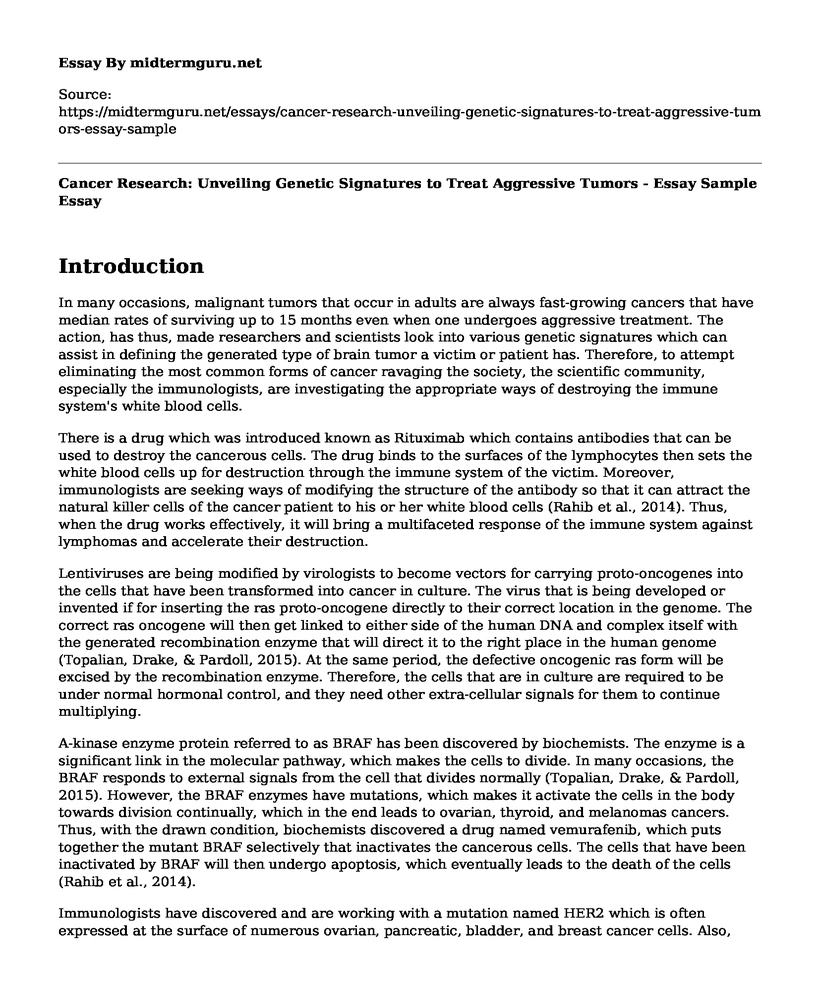Introduction
In many occasions, malignant tumors that occur in adults are always fast-growing cancers that have median rates of surviving up to 15 months even when one undergoes aggressive treatment. The action, has thus, made researchers and scientists look into various genetic signatures which can assist in defining the generated type of brain tumor a victim or patient has. Therefore, to attempt eliminating the most common forms of cancer ravaging the society, the scientific community, especially the immunologists, are investigating the appropriate ways of destroying the immune system's white blood cells.
There is a drug which was introduced known as Rituximab which contains antibodies that can be used to destroy the cancerous cells. The drug binds to the surfaces of the lymphocytes then sets the white blood cells up for destruction through the immune system of the victim. Moreover, immunologists are seeking ways of modifying the structure of the antibody so that it can attract the natural killer cells of the cancer patient to his or her white blood cells (Rahib et al., 2014). Thus, when the drug works effectively, it will bring a multifaceted response of the immune system against lymphomas and accelerate their destruction.
Lentiviruses are being modified by virologists to become vectors for carrying proto-oncogenes into the cells that have been transformed into cancer in culture. The virus that is being developed or invented if for inserting the ras proto-oncogene directly to their correct location in the genome. The correct ras oncogene will then get linked to either side of the human DNA and complex itself with the generated recombination enzyme that will direct it to the right place in the human genome (Topalian, Drake, & Pardoll, 2015). At the same period, the defective oncogenic ras form will be excised by the recombination enzyme. Therefore, the cells that are in culture are required to be under normal hormonal control, and they need other extra-cellular signals for them to continue multiplying.
A-kinase enzyme protein referred to as BRAF has been discovered by biochemists. The enzyme is a significant link in the molecular pathway, which makes the cells to divide. In many occasions, the BRAF responds to external signals from the cell that divides normally (Topalian, Drake, & Pardoll, 2015). However, the BRAF enzymes have mutations, which makes it activate the cells in the body towards division continually, which in the end leads to ovarian, thyroid, and melanomas cancers. Thus, with the drawn condition, biochemists discovered a drug named vemurafenib, which puts together the mutant BRAF selectively that inactivates the cancerous cells. The cells that have been inactivated by BRAF will then undergo apoptosis, which eventually leads to the death of the cells (Rahib et al., 2014).
Immunologists have discovered and are working with a mutation named HER2 which is often expressed at the surface of numerous ovarian, pancreatic, bladder, and breast cancer cells. Also, antibodies have been created against the surface protein of the generated mutant. The antibodies are then covalently bonded to a certain type of gene expression vector, which makes the cells to light up when luciferin is incubated in them from fireflies. The luciferin gene is then acquired by the vector into the cancer cells (Rosenberg, Yang, & Restifo, 2004). The antibody is then bonded to some expression vector which carries a normal gene of HER2 into the mutant cancerous cells. The action thus leads to the correction of cancer genes that reduce the multiplication of malignant tumors.
References
Rahib, L., Smith, B. D., Aizenberg, R., Rosenzweig, A. B., Fleshman, J. M., & Matrisian, L. M. (2014). Projecting cancer incidence and deaths to 2030: the unexpected burden of thyroid, liver, and pancreas cancers in the United States. Cancer Research, 74(11), 2913-2921. Doi: 10.1158/0008-5472.CAN-14-0155
Rosenberg, S. A., Yang, J. C., & Restifo, N. P. (2004). Cancer immunotherapy: moving beyond current vaccines. Nature medicine, 10(9), 909. Retrieved from https://www.nature.com/articles/nm1100
Topalian, S. L., Drake, C. G., & Pardoll, D. M. (2015). Immune checkpoint blockade: a common denominator approach to cancer therapy. Cancer cell, 27(4), 450-461. Retrieved from https://www.sciencedirect.com/science/article/pii/S1535610815000896
Cite this page
Cancer Research: Unveiling Genetic Signatures to Treat Aggressive Tumors - Essay Sample. (2023, Feb 02). Retrieved from https://midtermguru.com/essays/cancer-research-unveiling-genetic-signatures-to-treat-aggressive-tumors-essay-sample
If you are the original author of this essay and no longer wish to have it published on the midtermguru.com website, please click below to request its removal:
- Sign Language Interpreting and Text Alternatives for Deaf Students - Assignment Example
- Social Work Graduate School Personal Statement
- Essay Saple on Organ Selling
- Pollution: 7M Deaths Per Year, How To Control It? - Essay Sample
- Elderly Anemia: Evaluation & Management Guidelines - Essay Sample
- County Health Rankings: Grading US Counties on Health Status - Essay Sample
- Kankakee Valley Park District Closes Splash Valley Aquatic Park - Essay Sample







